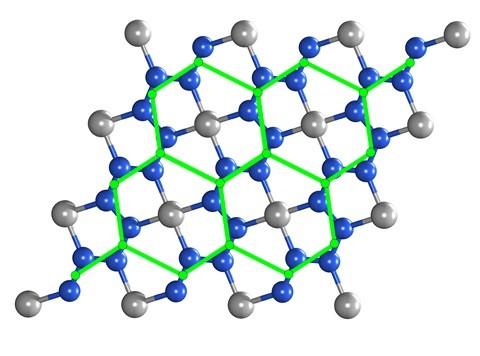BeN4: A new class of Dirac materials synthesized at high pressure-temperature conditions

An international group of researchers which includes collaborators from Universität Bayreuth (Germany), Linköping University (Sweden), Radboud University (Netherlands), National University of Science and Technology (Russia), Wuhan University (China), and Carnegie Institution for Science (Washington, DC) using synchrotron facilities at DESY (Hamburg), GSECARS (APS), and HPCAT (APS), recently reported the discovery of a novel 2D material – Beryllonitrene (BeN4), that was synthesized at high pressure – high temperature conditions. Unlike graphene, which is a popular, carbon based 2D material, this material has unusual electronic properties that originate from the alternating arrangement of BeN4 pentagons and Be2N4 hexagons shown below. This distorted lattice gives rise to unique electronic properties that would make this material excellently suited for quantum technology which could be produced on an industrial scale in some future times. The researchers have produced pG of this in a diamond anvil cell subjected to pressures of the order of a million atmospheres and temperatures in the region of 1000 K using laser heating. They report the stabilization of this material on decompression (quench recovery) which makes it an exciting prospect for large scale synthesis. Theoretical calculations based on the structural evidence garnered from detailed in-situ, diffraction studies at GSECARS and HPCAT, have shown that the distorted honeycomb structure would result in the presence of Dirac points in the electronic structure at the Fermi level. This portends to this material exhibiting unique electronic properties. The recent report published in the Phys. Rev. Lett. (https://link.aps.org/doi/10.1103/PhysRevLett.126.175501) was highlighted as an editor’s suggestion.
For more, see: High-Pressure Synthesis of Dirac Materials: Layered van der Waals Bonded BeN4 Polymorph. Maxim Bykov, Timofey Fedotenko, Stella Chariton, Dominique Laniel, Konstantin Glazyrin, Michael Hanfland, Jesse S. Smith, Vitali B. Prakapenka, Mohammad F. Mahmood, Alexander F. Goncharov, Alena V. Ponomareva, Ferenc Tasnádi, Alexei I. Abrikosov, Talha Bin Masood, Ingrid Hotz, Alexander N. Rudenko, Mikhail I. Katsnelson, Natalia Dubrovinskaia, Leonid Dubrovinsky, and Igor A. Abrikosov, Phys. Rev. Lett. 126, 175501 – Published 26 April 2021
